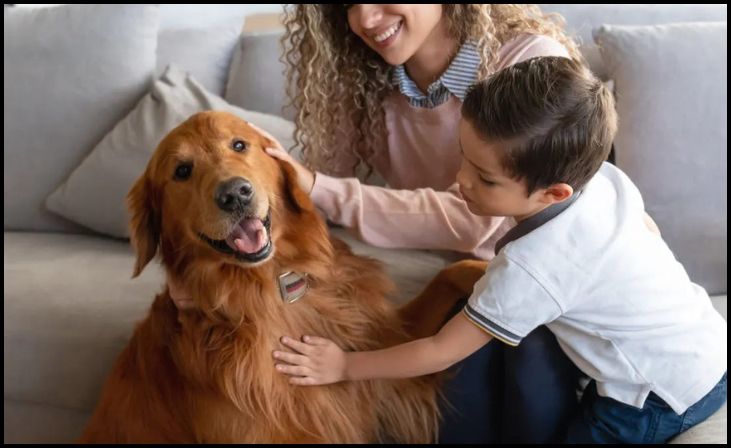Ensuring your dog leads a healthy and happy life requires a blend of proper nutrition, regular exercise, mental stimulation, and regular veterinary care. Dogs, like humans, need a balanced lifestyle to thrive. Whether you’re a new dog owner or have had your furry friend for years, these ten tips will help you provide the best care possible. By following these guidelines, you’ll ensure your dog remains a loyal and joyful companion for years to come.
10 Tips For Keeping Dogs Healthy And Happy
1. Provide Balanced Nutrition
A well-balanced diet is crucial for your dog’s health. Quality commercial dog food that meets the nutritional standards set by the Association of American Feed Control Officials (AAFCO) is a good choice. These foods are formulated to provide all the necessary nutrients in the right proportions. Avoid giving your dog table scraps or foods high in fat and sugar, as these can lead to obesity and other health issues. Always consult your veterinarian to determine the best diet for your dog’s specific breed, age, and health condition. Fresh water should always be available to keep your dog hydrated.

2. Ensure Regular Exercise
Regular exercise is essential for maintaining your dog’s physical and mental health. Dogs healthneed daily physical activity to prevent obesity, keep their joints flexible, and maintain a healthy heart. Depending on your dog’s breed, age, and energy level, this can range from a brisk walk to vigorous play sessions. Exercise also provides mental stimulation, which helps to prevent behavioral problems. Incorporate activities like fetch, agility training, or even swimming to keep your dogs health engaged, and active. Regular exercise strengthens the bond between you and your pet.
Read Also: 10 Essential Grooming Tips for Dogs Care
3. Schedule Routine Veterinary Check-ups
Regular veterinary visits are critical for detecting health issues early and ensuring your dog is up-to-date on vaccinations. Annual or biannual check-ups allow your vet to perform thorough physical examinations, dental cleanings, and necessary lab tests. Early detection of illnesses can significantly improve treatment outcomes. Discuss any changes in your dog’s behavior, appetite, or energy levels with your vet, as these can be indicators of underlying health issues. Preventative care, such as parasite control and vaccinations, is essential to keep your dog healthy and safe from common diseases.
4. Maintain Dental Health

Oral health is often overlooked but is vital for your dogs health overall well-being. Poor dental hygiene can lead to periodontal disease, which can cause pain, tooth loss, and systemic health issues. Brush your dog’s teeth regularly with dog-specific toothpaste and provide dental chews or toys designed to reduce plaque and tartar buildup. Regular professional dental cleanings by your vet are also important. Signs of dental problems include bad breath, difficulty eating, and swollen or bleeding gums. By maintaining your dog’s dental health, you can help prevent serious health problems and ensure your pet remains comfortable and pain-free.
5. Keep Up With Grooming
The health and comfort of your companion are contingent upon regular grooming. Depending on the breed, your dog may need frequent brushing to prevent matting and reduce shedding. Bathing your dog helps keep their coat clean and free of parasites. Regular nail trims are necessary to prevent overgrown nails, which can cause discomfort and affect your dog’s ability to walk properly. Ear cleansing is also crucial, particularly for breeds that are susceptible to ear infections. Regular grooming sessions also provide an opportunity to check for abnormalities, such as lumps, bumps, or skin issues, and can help you bond with your pet.
6. Provide Mental Stimulation
Mental stimulation is as important as physical exercise for your dog’s well-being. Dogs are intelligent animals that require mental challenges to stay happy and healthy. Keep your dog’s mind engaged by offering interactive activities, puzzle toys, and training sessions. Teaching new tricks and commands not only stimulates your dog mentally but also strengthens your bond. To prevent boredom and maintain interest, it is important to rotate objects on a regular basis. Mental stimulation can prevent destructive behaviors that often arise from boredom and anxiety, ensuring your dog remains content and well-behaved.
7. Socialize Your Dog
Socialization is essential for the development and behavior of your companion. From an early age, it is important to expose your dog to a variety of environments, individuals, and other animals. Positive social experiences help your dog develop confidence and reduce the likelihood of fear-based aggression. Puppy classes and dog parks are great places for socialization. Proper socialization helps your dog become well-adjusted and reduces stress in unfamiliar situations. It also enhances your dog’s ability to communicate and interact appropriately with other dogs and people, leading to a more balanced and happy pet.
8. Ensure Safety

Keeping your dog safe is a top priority. Always use a leash when walking your dog in public places to prevent accidents and injuries. Ensure your home and yard are secure to prevent your dog from escaping. Microchipping your dogs health and keeping the information up to date increases the chances of being reunited if your dog gets lost. Provide a safe space in your home where your dog can retreat and feel secure. Safety measures also include being cautious with household items that can be toxic to dogs, such as certain plants, foods, and chemicals.
9. Train Your Dog
A well-behaved and content dog necessitates training. Basic obedience training helps establish a communication system between you and your pet, ensuring they understand your expectations. Consistency, positive reinforcement, and perseverance are essential components of effective training. Teaching commands like sit, stay, come, and leave it can enhance your dog’s safety and improve your relationship. Advanced training, such as agility or therapy dog training, can provide additional mental and physical stimulation. Training not only makes your dog more manageable but also boosts their confidence and strengthens your bond.
Read Also: 10 Effective Ways to Train Your Dog at Home
10. Show Love and Affection
Love and affection are fundamental to your dog’s happiness. Dogs are social animals that thrive on attention and companionship. Spend quality time with your dog, whether it’s through play, cuddling, or simply being present. Positive interactions with their owners can improve your dog’s mood and reduce anxiety. Recognize and reward good behavior with treats, praise, and affection. Building a strong emotional bond with your dog provides them with a sense of security and belonging, contributing significantly to their overall happiness and well-being.
Conclusion
Keeping your dog healthy and happy requires a commitment to their physical, mental, and emotional needs. By providing balanced nutrition, regular exercise, proper grooming, mental stimulation, and veterinary care, you can ensure your dog leads a fulfilling life. Socialization, training, and safety measures further enhance their well-being, while love and affection strengthen your bond. Following these tips will help you create a loving and nurturing environment for your dog, ensuring they remain a loyal and joyful companion for years to come.
FAQs
How often should I take my dog to the vet?
Most dogs should visit the vet at least once a year for a check-up and vaccinations. Puppies, senior dogs, and those with health issues may require more frequent visits.
What should I do if my dog refuses to eat their food?
If your dog suddenly stops eating, it could indicate a health issue. Consult your veterinarian to rule out any medical conditions. Sometimes, switching to a different food or feeding routine can help.
How can I tell if my dog is getting enough exercise?
A well-exercised dog typically shows fewer signs of boredom or destructive behavior. If your dog is calm and content after physical activity, they are likely getting enough exercise. Consult your vet for breed-specific exercise recommendations.



